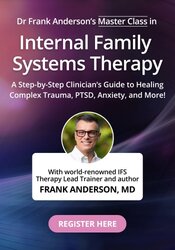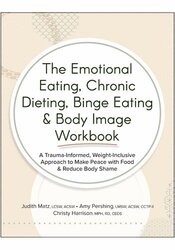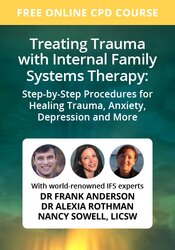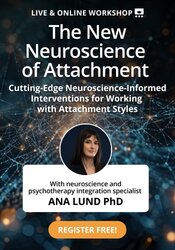Enrol in an online course today for flexible, self-paced learning—no fixed schedule required. Plus, enjoy lifetime access to course materials for convenient revisiting.


-
 Online CourseFrank Anderson’s Master Class in Internal Family Systems TherapyValue: £999.98 *£129.98Frank Anderson’s Master Class in Internal Family Systems Therapy29 Jan, 2024Frank Anderson’s Master Class in Internal Family Systems TherapyValue: £999.98 *£129.98
Online CourseFrank Anderson’s Master Class in Internal Family Systems TherapyValue: £999.98 *£129.98Frank Anderson’s Master Class in Internal Family Systems Therapy29 Jan, 2024Frank Anderson’s Master Class in Internal Family Systems TherapyValue: £999.98 *£129.98 -
Live Events
In-Person or Online— learn with others, ask questions, and use your attendance to earn your CPD.
 Live Video WebcastJoin Bessel van der Kolk, MD, along with Licia Sky, BFA, LMT, in a transformational clinical trauma training. This 2-day conference will serve as both a guide and an invitation – an invitation to dedi£344.99£0.00Join Bessel van der Kolk, MD, along with Licia Sky, BFA, LMT, in a transformational clinical trauma training. This 2-day conference will serve as both a guide and an invitation – an invitation to dedi11 Dec, 2025Join Bessel van der Kolk, MD, along with Licia Sky, BFA, LMT, in a transformational clinical trauma training. This 2-day conference will serve as both a guide and an invitation – an invitation to dedi£344.99£0.00
Live Video WebcastJoin Bessel van der Kolk, MD, along with Licia Sky, BFA, LMT, in a transformational clinical trauma training. This 2-day conference will serve as both a guide and an invitation – an invitation to dedi£344.99£0.00Join Bessel van der Kolk, MD, along with Licia Sky, BFA, LMT, in a transformational clinical trauma training. This 2-day conference will serve as both a guide and an invitation – an invitation to dedi11 Dec, 2025Join Bessel van der Kolk, MD, along with Licia Sky, BFA, LMT, in a transformational clinical trauma training. This 2-day conference will serve as both a guide and an invitation – an invitation to dedi£344.99£0.00 -
-
Books
Discover the transformative insights from renowned authors like Judith Matz, Amy Pershing, and Christy Harrison. Explore their works to gain a deeper understanding of mental health, and more.
 BookWritten by three leading experts in the fields of disordered eating, mental health, and trauma-informed care, this book will become your go-to guide for learning how to reject diet culture, heal your£18.99Written by three leading experts in the fields of disordered eating, mental health, and trauma-informed care, this book will become your go-to guide for learning how to reject diet culture, heal your20 Feb, 2024Written by three leading experts in the fields of disordered eating, mental health, and trauma-informed care, this book will become your go-to guide for learning how to reject diet culture, heal your£18.99
BookWritten by three leading experts in the fields of disordered eating, mental health, and trauma-informed care, this book will become your go-to guide for learning how to reject diet culture, heal your£18.99Written by three leading experts in the fields of disordered eating, mental health, and trauma-informed care, this book will become your go-to guide for learning how to reject diet culture, heal your20 Feb, 2024Written by three leading experts in the fields of disordered eating, mental health, and trauma-informed care, this book will become your go-to guide for learning how to reject diet culture, heal your£18.99 -
CPD Resources
Get expert guidance, practical workbooks, online courses, and more.
 Online Course3 Mar, 2023
Online Course3 Mar, 2023 -
Staff Training
We specialise in meeting the unique training needs of individual teams, bringing staff members together to benefit from the latest therapeutic knowledge, insights and skills. Access a wide range of trainings from the latest trauma treatment modalities, child and adolescent trainings and many more.
×












